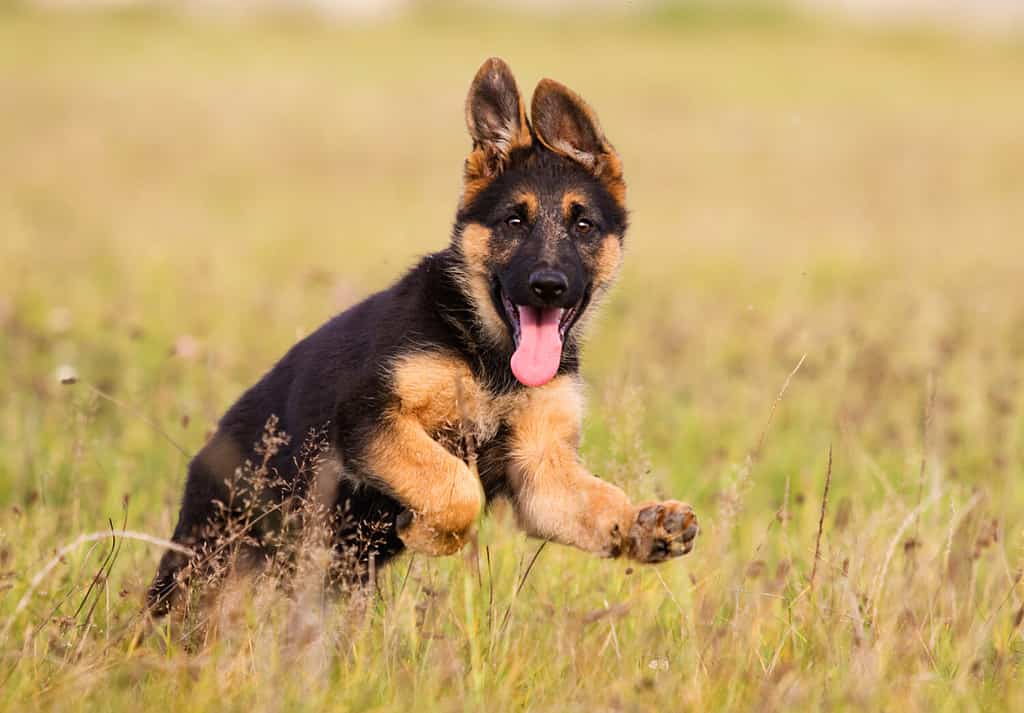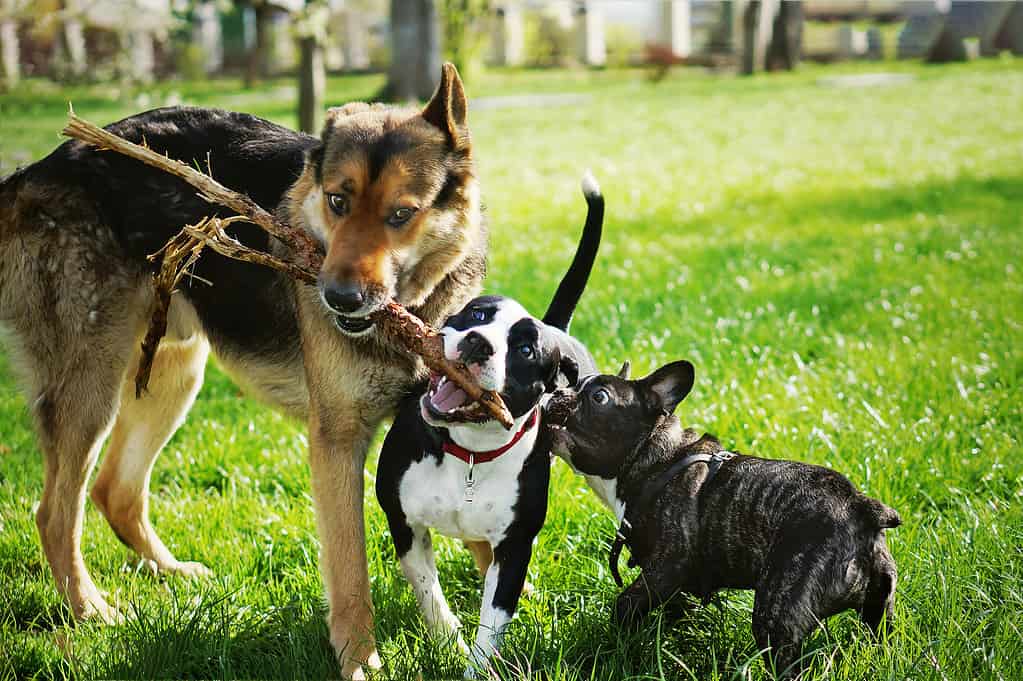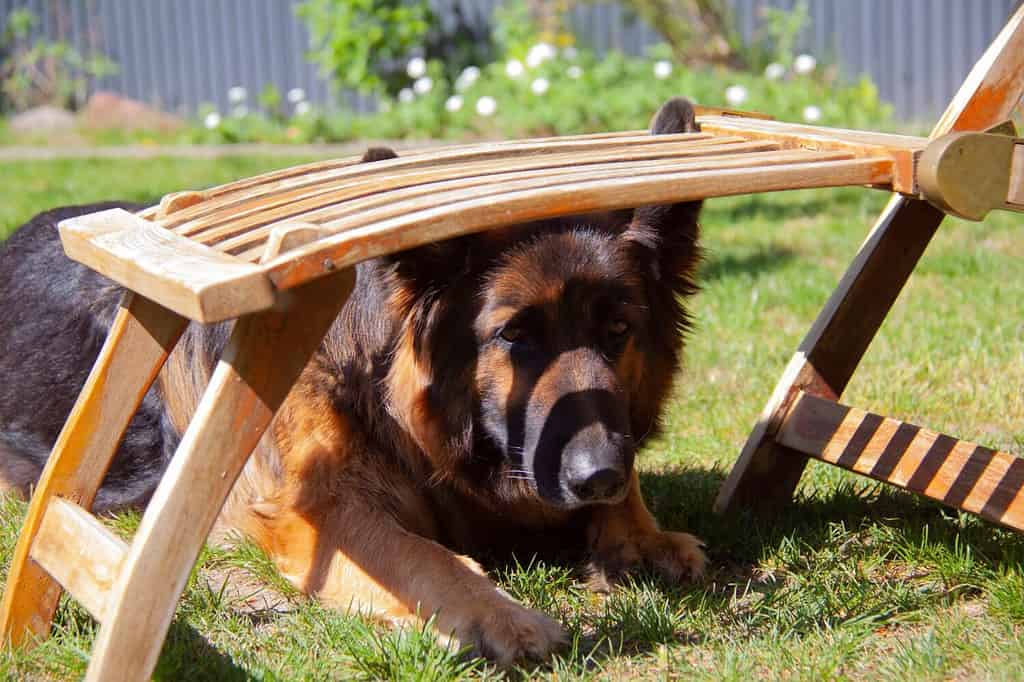King Shepherd Summary
King shepherds are incredibly powerful and strong dogs that were developed in the United States in the 1990s. This breed isn’t purebred. Instead, it is a mix between the German Shepherd, the Shiloh Shepherd, and the Alaskan Malamute. They’re primarily built for huge, muscular appearance, but they can also be friendly, protective pets when properly socialized and trained.
King Shepherd Growth and Weight Chart by Age
| Age | Weight | Height |
|---|---|---|
| 2 months | 15-25 pounds | 12-14 inches |
| 3 months | 25-35 pounds | 14-16 inches |
| 4 months | 35-50 pounds | 18-20 inches |
| 5 months | 45-60 pounds | 18-20 inches |
| 6 months | 55-75 pounds | 20-22 inches |
| 7 months | 65-80 pounds | 22-24 inches |
| 8 months | 70-85 pounds | 24-26 inches |
| 9 months | 75-90 pounds | 24-26 inches |
| 10 months | 75-95 pounds | 24-26 inches |
| 11 months | 75-95 pounds | 24-26 inches |
| 12 months | 75-100 pounds | 24-26 inches |
| 18 months | 80-105 pounds | 24-26 inches |
Remember that these dogs are a mixed breed, and they vary widely. Therefore, it isn’t odd for them to fall outside of these ranges at all.
When Will My King Shepherd Stop Growing?
King shepherds are fairly large dogs. Therefore, they usually take between 18 months to 2 years. They tend to reach their full height before their full weight. It takes several months after they teach their full height for them to gain their full muscle mass and “bulk up.”
That said, their growth does tend to slow down substantially by nine months. At this point, they will no longer look like puppies, though they won’t be at their full size, either.
Males usually get larger than females. This means that they also tend to take longer to reach their full size, while females may be done growing sooner. Genetics and diet also play a role.
Plus, these dogs are not purebred. Therefore, their growth rate can vary substantially. Some dogs may grow much faster than others without it being considered unusual.
How Big Will My King Shepherd Be When It’s Fully Grown?
King shepherds vary considerably in height and weight, as they are a mixed breed. Therefore, their traits aren’t as set in stone as other breeds, including their weight and height.
Male king shepherds tend to be much larger than females, weighing between 90 to 150 pounds. They’re absolutely massive dogs.
On the other hand, females are a bit smaller at between 75 to 120 pounds. It’s possible for larger females to be bigger than smaller males. However, females are typically on the smaller side.
There can be variations outside of this range, too. Currently, no kennel clubs recognize this breed. Therefore, there isn’t an “official” minimum or maximum weight. Breeders can produce larger and smaller dogs while still calling them king shepherds. Your best bet is to look at the size of your dog’s parents, which should help you determine the potential size of your puppy.
When Should My King Shepherd Be Spayed or Neutered?
There is a lot of debate on when dogs should be spayed or neutered. Many vets recommend that dogs be spayed and neutered as soon as possible, preferably before six months of age. Doing the procedure early helps prevent accidental pregnancy. Not only does this help with overpopulation, but it also helps prevent females from getting pregnant before they’re ready (which can create a host of health problems).
Some breeders may also require that puppies be spayed or neutered ASAP, especially if you didn’t purchase breeding rights. Breeders do not want accidental pregnancies harming their puppies or the breed overall. Typically, you need permission to use a puppy for breeding purposes.
That said, there is a lot of evidence that neutering or spaying a dog too early causes health problems, especially for larger breeds like the king shepherd. The reproductive organs produce hormones that are used to help develop the bones and joints. If the dog is spayed or neutered too early, they will not produce these hormones and may be at a greater risk of joint issues.
In a perfect world, everyone would be able to avoid accidental pregnancies and due the procedure later. However, we don’t live in a perfect world, and accidental pregnancies can happen to even the best dog owners. Therefore, you need to weigh the pros and cons of timing carefully to make the right decision for your dog.
When Should My King Shepherd Be House Broken?
Your king shepherd should begin potty training as soon as you bring them home. Many breeders will begin this process very early, but you’ll need to continue it at home. Early house training prevents bad habits from forming, which makes the whole process go much smoother.
That said, it takes many puppies months to go outside with little to no accidents. The process is more complicated than most humans give credit for. Your dog has to learn when they need to use the bathroom, where they’re supposed to use the bathroom, and how to tell you when they need to go outside. This sequence is complicated and will take dogs a while to master. Therefore, you shouldn’t expect a tiny puppy to master potty training right away.
Patience and consistency are key to correctly house-training your dog. Plan to take your puppy outside as much as possible in the first few weeks of training. After meals, before bed, and upon waking are the most important times, but you should also take them outside about every two hours during the day. The more you take your puppy out, the more chances they have for success.
Of course, no one is perfect, and accidents are bound to occur. When they do happen, calmly clean up the mess with a quality enzymatic cleaner to remove the smell. Aim to figure out why your dog had an accident. Did you not take them out enough? Did the spot still smell like a previous accident? If you can figure out why, you can correct the problem and prevent it from happening again.
Avoid punishing your dog for accidents. At best, your dog won’t understand why you’re angry. At worst, they will begin to hide whenever they need to use the bathroom, as they’ll associate needing to go with you being angry. Of course, that’s the exact opposite of what you want.
When Should My King Shepherd Stop Eating Puppy Food?
Puppy food contains all the extra nutrients and calories your dog needs to grow properly when they are little. However, as your dog gets bigger, they don’t need all these nutrients and calories anymore. In fact, continuing to eat puppy food for too long can cause obesity, which comes with its own problems.
Therefore, as soon as your dog is almost done growing, it’s time to start transitioning to puppy food. For more king shepherds, this will be around 18 months. However, some females will need to be transitioned a couple of months earlier. Whenever your dog’s growth slows considerably, it’s probably time to transition them to an adult formula.
That said, you should be working with your vet to determine when your dog has finished growing and should be switched to adult food. Puppies need several checkups in the first few years, and your vet should tell you that it’s time to switch to adult food at one of these appointments.
Be sure the adult formula you switch to is designed for larger breeds. King shepherds are very big, so they need a specialty formula.
When Will My King Shepherd Start Losing Teeth?
King shepherds tend to develop slower than most other breeds. However, losing their teeth is one area where this isn’t true. Like all dogs, they tend to start losing their teeth around three to four months. This process usually takes a few months, so most dogs are done in six months.
However, this process can vary a lot in timing without it being worrisome. Some dogs just take longer to lose their teeth than others, and some may start very early or late. As long as no baby teeth are being retained, your dog’s vet will likely let the process continue normally.
While teething, puppies will feel a lot of discomfort. Therefore, it’s important to provide plenty of chew toys for your pooch to munch on. Otherwise, they may chew on things they aren’t supposed to, like your phone charger. You should teach your canine not to chew on things they shouldn’t by redirecting them to their own chew toys. You may have to try several different types of chew toys before you find a type that your dog likes.
When Should I Start Training My King Shepherd?
King shepherds are often adopted because of their big, imposing size, which can make them great guard dogs. However, this trait also means that they need plenty of training. Otherwise, they can be potentially dangerous.
You should start training your puppy as soon as they come to your home. Often, quality breeders will start training their dogs before they even go to their forever homes. Ten weeks is not too early to start these dogs in the least.
Your puppy is learning habits as soon as they walk into your home. So, it’s important to start intentionally teaching the habits you want your dog to have as early as possible. For instance, if you don’t want your dog on the couch, don’t let them on the couch from day one.
You should also start obedience training at a relatively young age. Your puppy can start learning how to “sit” from a very young age, even if it takes them a little bit longer than it might an adult. Puppies are little sponges at this age, so they typically pick up on things very fast.
What Cues Should I Teach My King Shepherd First?
There are some commands that need to be taught before others. Some are easier or more practical, for instance. That said, your dog doesn’t actually need to master one cue before moving on to the next in most cases. As long as they have a general idea of the command, you can often move on to teaching the next one, too.
Here’s a list of commands we recommend teaching your king shepherd before moving on to more challenging training.
- Sit: This command is necessary for several others to be taught, so we typically recommend teaching it first. Make sure your dog has a good understanding of it before moving on. Preferably, they should follow the command at least 80% of the time.
- Leave It: Start working on “leave it” as soon as possible. This command can prevent your dog from eating things they shouldn’t, and you can even use it to keep them from chasing things they shouldn’t. However, it takes dogs a long time to master, so plan on working on it for months.
- Stay: Once your dog can sit, start working on “stay.” It does take dogs a little bit to master this command, but they must be able to sit first.
- Come: As soon as your dog has a basic understanding of “stay,” start teaching them “come.” You can teach both of these commands at about the same time.
- Wait: This command isn’t as essential as others, but it can be helpful in preventing your dog from running out the door.
When Will My King Shepherd Calm Down?
These dogs may have been developed relatively recently and mostly as companion animals. However, they are extremely active dogs. They require tons of exercise each day, and if you don’t keep up with their exercise need, they will be hyperactive and often poorly behaved. Meeting this need can be a lot for families that aren’t particularly active. If you aren’t outside being active for several hours a day, a king shepherd may not be the best option for you.
These dogs really don’t calm down, especially males. They remain fairly active and intense throughout their life. However, they may start losing some of their puppy-like exuberance at around 18 months old. Still, that doesn’t necessarily mean they’ll start being less active or require less exercise.
Common Health Issues Your King Shepherd Might Experience
As a mixed breed, these dogs tend to be healthier than many other breeds out there. They’re drawing for a wider gene pool than purebred dogs, so they tend to have fewer genetic issues than others.
That said, their large size does prove problematic in some cases. They’re prone to joint issues like hip dysplasia due to their larger size. They may also be prone to bloat, a life-threatening condition that mostly occurs in bigger dogs. It’s important to learn the symptoms of both of these conditions so that you can get your dog to the vet for treatment as soon as possible. Bloat can be deadly in only a few hours, so it requires quick veterinary care.
Like many dogs, king shepherds can also develop eye conditions. Progressive retinal atrophy is sadly pretty common across many breeds and generally leads to blindness. It’s genetic and isn’t currently curable. Other eye issues, like cataracts, can also occur. Some may lead to blindness, while others are treatable.
Responsible breeders will health test their dogs before breeding to prevent passing on genetic conditions. A dog’s hips can also be x-rayed before breeding to help prevent hip dysplasia from being passed onto their puppies. However, hip dysplasia and many other conditions also have an environmental factor (one reason it’s important to feed these dogs large breed puppy formulas). Therefore, quality breeding alone won’t prevent them.
Pictures of King Shepherds as Puppies

King shepherds start out very small. However, they quickly grow to be the 100-pound adults most people recognize them as.
©Happy monkey/Shutterstock.com
Pictures of King Shepherd at 6 Months

At six months, these dogs are still puppies. That said, they are already much larger than most other dogs at this age.
©Marina Vedernikova/iStock via Getty Images
Pictures of Fully Grown German Shepherds

As adults, these dogs can be absolutely massive. However, some aren’t much bigger than your average
German Shepherd
, especially females.
©Debbie Hendriks/Shutterstock.com
The photo featured at the top of this post is © Oakland Images/Shutterstock.com
Ready to discover the top 10 cutest dog breeds in the entire world?
How about the fastest dogs, the largest dogs and those that are -- quite frankly -- just the kindest dogs on the planet? Each day, AZ Animals sends out lists just like this to our thousands of email subscribers. And the best part? It's FREE. Join today by entering your email below.
Thank you for reading! Have some feedback for us? Contact the AZ Animals editorial team.






